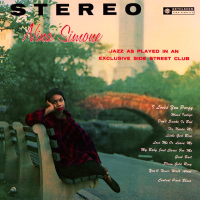Nina Simone's 1959 Debut "Little Girl Blue" Remains Timeless
Simone was a classically trained concert pianist (Julliard) but because of the overt discrimination at the time, her career was stymied. She began playing jazz in Atlantic City and New York clubs and recorded this album at age twenty five.
The label founder Gus Wildi wisely gave Simone complete control and she produced an eclectic, sophisticated album that showcased her deft arranging, her unusual mix of jazz and classical piano playing and especially her soulful, intimate singing.
Here, and especially on Nina Simone at Carnegie Hall (Colpix/Pure Pleasure PPAN SCP 455), you always have the sensation that she’s singing to just you, so intimate is her communication and so intense is her gravitational pull.
Her piano style is at times fierce and blocky as you’d expect from a jazz artist, and at other times heavily arpeggiated and almost baroque as you’d expect from a classical musician, but at all times, Simone is deep and soulful as you’d expect from someone steeped in gospel and church music.
She’s backed by Jimmy Bond on bass and Al Heath on drums and that’s all that’s needed as she idiosyncratically covers familiar territory like “Mood Indigo”, “Don’t Smoke In Bed”, “Love Me Or Leave Me” and “Porgy”.
The recording quality is extremely high. Transparency and timbral accuracy are high points, the ‘stereo’ spread, the low point. This sounds as if it was a two track recording meant to be mixed to mono and in fact, I have a mono original that I prefer spatially, but it can’t otherwise begin to compare to this reissue’s remarkable clarity, transparency and black backgrounds.
Simone’s voice is in one channel only, the rhythm section of piano, drums and bass in the other, though there is some attempt to integrate the two in the ambience, with the drums having a “stereo” spatial quality. It’s as if the engineer in 1957 was experimenting with stereo as he went. Don’t let that stop you from buying this “must have” record.
I got my original at a garage sale. There were no records out but I asked if there were any. The woman said “yes”, but she didn’t want to sell the few she had. She didn’t own a turntable. I asked if I could see them and what she had were four records: two original Nina Simone albums and two original Sam Cooke albums on Keene!
In the end I transferred them for her to CD on the Continuum Caliburn and you can bet even digitized she’d never heard them sound that way, so it was a fair trade! That’s what’s great about records: you always remember the “back story”.
The word “unique” gets tossed around so often it loses its meaning but its correctly applied to Miss Nina Simone. She recorded for many labels including Colpix, RCA, and ran the gamut from jazz to pop to, rock to folk.
I’d hoped to do an extended feature called “Nina Simone on Record” but reality set in. That would take more time than I currently have. So if you go exploring, stay away from the Four Men With Beards reissues that are surely cut from digital and probably at CD resolution. Speakers Corner is always (or mostly) from tape as are Pure Pleasure to the best of my knowledge.
If you like this record (which you will), I can recommend forbidden fruit (Pure Pleasure/Colpix PPAN SCP 419) a double LP set consisting of the original Colpix release plus extra tracks that the reissue annotation says “the aural evidence” suggests were from the same sessions, though there’s no proof.
Interestingly, Pure Pleasure released in mono Little Girl Blue but titled “The Original…And Best of Nina Simone with a different cover. While I prefer the mix, the perspective is flat and the overall sound hard and bright. It sounds as if it was cut from an undistinguished digital file that had been dynamically compressed during digitization and sounds as if cheesy reverb was recently added. Were you to hear it compared to the Analogue Productions stereo reissue, you might at first not think it was the same recording. The emotional content of one has been stripped away,
Analogue Productions’ reissue of Little Girl Blue cut by Ryan K. Smith at Sterling Sound from the original stereo master tape, pressed at QRP on 200 gram vinyl and presented in a gatefold “Tip on” jacket is well worth the money. It’s a classic you’ll play often and enjoy every time.




